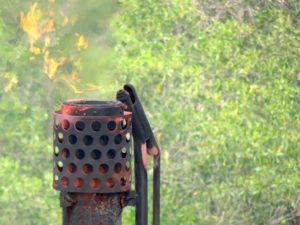
Japanese drone provider Terra Drone is expanding its Asian footprint after conducting UAV inspections for energy giant Chevron.
Terra Drone’s Indonesian subsidiary deployed a multirotor drone equipped with high-resolution RGB and thermal cameras to inspect onshore flare stacks at one of the nation’s largest oil fields in Rokan, Sumatra.
Flare stacks are towers used to burn off flammable gas in order to relieve pressure.
Chevron generally inspects flare stacks using binoculars – a method that doesn’t give details a close-up probe can provide.
“Terra Drone’s inspection drone is capable of capturing photos with excellent quality and clarity to enable inspectors to accurately assess the condition of the flare stacks,” a company statement notes. “The radiometric thermal camera mounted on the drone studies the performance and function and identifies temperature anomalies on the flare stacks.”
Following the mission, the drone transmits data to generate a detailed report with recommendations.
“Going forward, the many benefits and applications of drones will be an attraction for oil and gas companies to adapt the them in their daily operations,” says Michael Wishna Wardana, Managing Director of Terra Drone Indonesia.
The Indonesian contract is the latest oil-and-gas mission Terra Drone has captured in as many months.
The company established a branch in Angola in May after capturing several energy-sector contracts. Earlier this year, Terra Drone partnered with Brazilian company Plimsoll UAV to form a joint venture called – surprise – Terra Drone Brazil.
Oil-and gas inspections continue to fuel new growth markets for drone players. Energy companies recently launched the Energy Drone Coalition and industry groups are popping up at more UAV-facing expos. Drone company AviSight has added former Shell Oil CEO Marvin Odum and former EOG Resources CEO Gary Thomas.
Companies like CyPhy Works, Inc. and Pilot Thomas Logistics provide drone services to customers in the oil and gas industry using CyPhy’s Persistent Aerial Reconnaissance and Communications (PARC) system, a persistent drone with recorded flights of 200+ hours.
“UAS application has already proven to be the fastest, most effective and lowest cost method for surveillance and inspection of critical infrastructure,” Thomas said. “[With] human-drone technology and analytics, we can shift from being reactive to proactive and preventive in our operations.
Jason is a longstanding contributor to DroneLife with an avid interest in all things tech. He focuses on anti-drone technologies and the public safety sector; police, fire, and search and rescue.
Beginning his career as a journalist in 1996, Jason has since written and edited thousands of engaging news articles, blog posts, press releases and online content.
Email Jason
TWITTER:@JasonPReagan
Subscribe to DroneLife here.







[…] by forming global partnerships, opening services centers around the world. They’ve acquired industry-specific expertise, allowing the company to serve multiple enterprise verticals, including the lucrative oil and gas […]